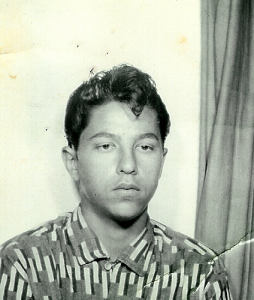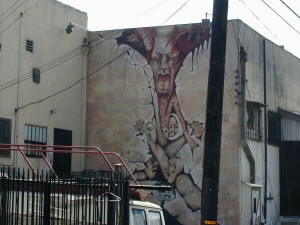Sr Felipe/Phillip I. Elkins
Can be heard doing his radio show “LA Sounds with Sr Felipe” broadcast live on 90.1 FM Chico every Tuesday night from 7:30 – 10:00 PM and streamed live on KZFR.org
People have been asking me when I’m going to read the stories again on my radio show that I wrote about growing up in East LA and becoming a cholo and getting drafted into the army and going to Vietnam. So maybe I’ll start with the story how it was that I grew up as a cholo and became Sr Felipe.
To answer that question you have to understand where I grew up. It was a part of East LA called City Terrace and there were a lot of cholos at the time. Cholos were also referred to as low-riders, vato locos or crazy guys. In the 50’s they were called pachucos.
But let me start with a story of visiting the de Young Museum in San Francisco.
A couple of years ago Sweet Lady T and I went to the de Young Museum in Golden Gate Park to see an art show of Chicano art collected by Cheech Marin. You know, the guy from Cheech and Chong. There were some fabulous works of art at the show painted with all my favorite bright colors and big, exciting images and bold artwork. It’s all the stuff I love and when I paint, it’s the style I use. That’s why I went to the show because my oldest brother Bob lives in Novato, CA and he called me up and said: “Hey, man you’ve got to go see the exhibit at the de Young Museum because the art work is the same painting style you do. You’d gotta go see it.”
So I went to the show and, man, the artwork collected by Cheech Marin knocked me out. Cheech obviously also loves it too because he published a book called “Chicano Vision (American Painters on the Verge.)” It has some beautiful pictures of some wonderful Chicano artists. I liked the book so much that I sprung for the hard cover edition that is very carefully done with high quality work. I love the book.
A good friend of mine named Nacho and I grew up together in City Terrace – And Nacho told me that Cheech also grew up somewhere nearby City Terrace. I remembered Cheech mentioned City Terrace in his song and movie “Born in East LA.” We always called City Terrace by it’s initials; C.T. I also happened to grow up and went to school with two of Cheech’s cousins named Bobby and Ralph.
The oldest friends in the world I have are a girl I grew up who lived across the street from me named Sally and her younger brother, Jerry. We’ve been very good friends since we were little kids and we still are good friends today.
Jerry is a friend with a guy who lived a few houses from us in City Terrace named Willie Herron.
Cheech writes about Willie Herron in the introduction of his Chicano Visions book. He mentions Willie and writes in the introduction of the book: “It was late at night in City Terrace in 1972, Willie Herron, a young Chicano artist, was walking home alone when he heard groans coming from a nearby alley. He made his way down the dark, gravelly pathway of debris and broken glass and saw his brother lying in a pool of blood.
As Herron tells it, ‘He had been stabbed maybe 12 times…tissue, blood and stuff was coming out of him.’ Seeing his brother so badly hurt by gang violence filled Herron with a rush of ambivalent feelings. The next morning he walked into the bakery whose backside faced the very alley where he had found his wounded sibling and asked if he could paint a mural on the wall.
By the end of a feverish day, he had produced a stylized rendering of muscular arms bursting up through a cement street. Integrating the texture of the rough, concrete wall with angry gang graffiti into his work, Herron had distilled a situation he knew all too well, and created what would become the most famous Chicano mural in the world, The Wall That Cracked Open. By metaphorically breaking open the wall, the artist took the Chicano art of his time beyond illustrative poster design and into the symbolic realm.
The mural became a tour de force of Chicano art by depicting familiar Chicano imagery – the praying madre (mother) with her crucifix, a calavera (skull) symbolizing death, conjoined with a Mexican wrestler’s mask – near an emotionally infused site. To this day the wall work is a testament to the social, economic, political and psychic violence prevalent in the poor barrios of Los Angeles.
Herron’s mural marked a new phase in the growth of the Chicano community’s artisti expression – its presence signaled the birth of fresh themes and styles. Earlier influences, such as Mexican muralism and European and New Your art trends, were subsumed by the socio-economic realities at hand. Something provocative and unique to Chicano art was born that day in the East Los Angeles alley in City Terrace.”
The mural done by Willie Herron is in the alley about 25 feet out the back door from the house I grew up in. I know the mural very well because I saw it every time I left the house.
If you look to the right going out the back door of my house you’ll see the mural by Willie Herron that Cheech Marin is talking about.
You’ll also see some graffiti that says “CT.” My bedroom was just behind the wall of the 2nd house on the corner of Mandalay and Carmalita Drives. You can just type in “Willie Herron murals” in Google Search and you’ll see the mural I’m talking about as well as many other murals Willie Herron has painted.
So back to how I grew up as a cholo. When I was 15 years old I had a girlfriend who was in a gang called El Hoyo Mara. Nonie had a brother a year older than she was her brother was also in El Hoya Mara.
You may have heard of the gang called White Fence. It’s the oldest gang in LA. El Hoya Mara and White Fence have always been rivals fighting over territory. One night my girlfriend’s brother was outside of El Hoya Mara territory and was caught by White Fence. He was stabbed to death and hung over a chain link fence in City Terrace.
My girlfriend found out who killed her brother and she was on the run because White Fence knew she knew who did it and they were going to keep her quiet. She was staying at my house and at other friend’s houses waiting to testify in court against the guys from White Fence who killed her brother.
Early in the morning a few days later the police came to my door and told me my girlfriend was raped and murdered.
She was 15 years old. Naturally I didn’t believe it but when I saw it on the front pages of the newspapers it began to sink in.
What’s all that got to do with the story? Well, who you are and where you grow up have a lot to do with how you present yourself to the world.
If I wasn’t a cholo when I grew up in City Terrace, I probably wouldn’t be here talking to you now.
Becoming a cholo was pure and simple a survival technique for me.
And to this day I still have friends who grew up in City Terrace who I love and who love me. They’re no longer cholos on the outside but maybe they are a little bit in the inside.
And some of them are still listening to the music we grew up with and are listening to me right now on KZFR.org on the Internet.
And I want to say hello to you and thank you for helping me become who I am toady, an old vato loco from City Terrace who somehow or other wound up in Chico and in Forest Ranch, California still kicking and still grooving to the music we grew up with.
In future blogs I’ll continue telling my story about growing up in City Terrace and how I somehow or other managed to survive all that long enough to get drafted and sent to Vietnam and have to survive that crazy life too.


